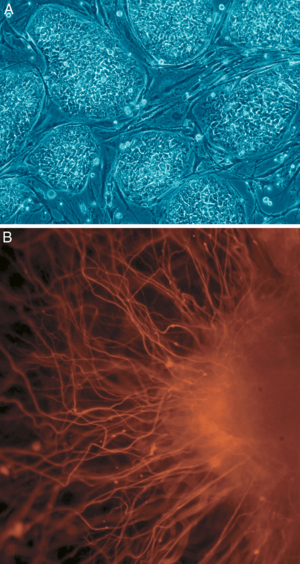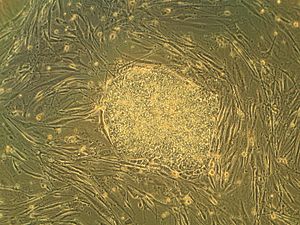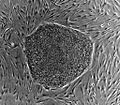Stem cell facts for kids
Stem cells are special cells in your body. They are like blank slates because they haven't decided what they want to be yet. These amazing cells can divide and change into many different types of specialized cells.
When a living thing grows, its stem cells become specialized. This means they take on specific jobs. For example, your skin, muscles, blood, bones, and nerves all have different kinds of cells. Stem cells are not yet specialized, so they can turn into any of these cell types. Your body also uses stem cells to fix damaged parts or replace old cells.
You can find stem cells in almost all plants and animals. They divide and turn into many different cell types. Scientists started learning a lot about stem cells in the 1960s.
There are two main types of stem cells in mammals (like humans): embryonic stem cells and adult stem cells. Embryonic stem cells are found in a very early stage of development. They can turn into any type of cell needed to build a body. Adult stem cells are found in older bodies. They act like a repair team, replacing specialized cells. They also help keep your blood, skin, and gut tissues healthy by constantly making new cells.
Scientists can grow stem cells in special dishes in a lab. In these dishes, stem cells can be made to turn into specialized cells, like muscle cells or nerve cells. Adult stem cells can be collected from different places, such as umbilical cord blood or bone marrow. Today, doctors use stem cells in some medical treatments. Researchers believe stem cells will be used in many more treatments in the future.
What Are Embryonic Stem Cells?
Embryonic stem cells (often called ES cells) are taken from a very early stage of an embryo. This stage is called a blastocyst. A human embryo reaches the blastocyst stage about 4 to 5 days after it is formed. At this point, it has between 50 and 150 cells.
The way these stem cells behave is affected by signals from other cells in the embryo. These signals help decide what the stem cells will turn into.
Images for kids
-
Mouse embryonic stem cells with a special glowing marker.
See also
 In Spanish: Célula madre para niños
In Spanish: Célula madre para niños






